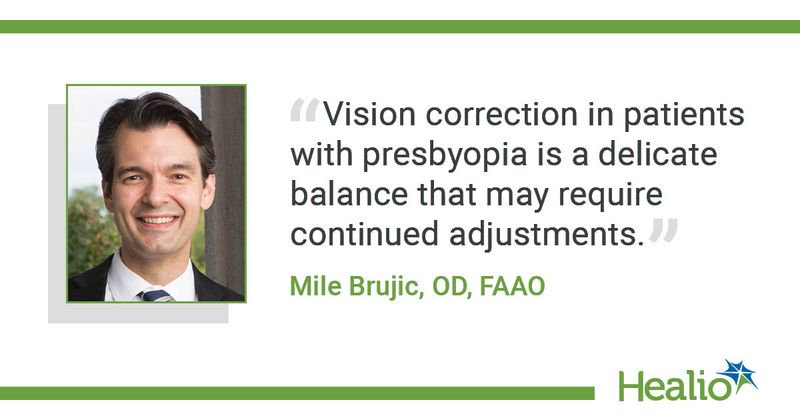Personalize treatment options, prioritize patient needs when treating presbyopia
Many patients I see in practice have some form of presbyopia, whether in an early phase or more severe.
About 80% of patients aged 45 to 55 years have presbyopia, and 16% of those individuals are without appropriate correction (Zebardast N, et al). In an economic modeling study, uncorrected or under-corrected presbyopia among patients younger than 50 years was associated with a potential productivity loss of $11 billion in the United States (Frick KD, et al).

Treating patients with presbyopia is often a process that requires an understanding of the patient’s needs and the nuances of the many treatments available today.
An expanding armamentarium
When a patient with presbyopia comes into my office, I make sure to inform them of the corrective options available before creating a treatment plan. Those include glasses, contact lenses, surgical treatments and prescription eye drops.
Glasses are a great option for patients who have no interest in surgery or placing anything in their eyes, such as contact lenses or eye drops. I let patients know we can build a general pair of glasses to improve their vision at most distances with progressive addition lenses that can also turn into sunglasses when outside, through photochromic technology. However, they may require another pair that is more appropriate for extended computer use. Glasses made with single-vision prescription are also an option for some patients and may better suit their needs.
Contact lenses are an option for patients who are willing and motivated to use them. Recent advancements in lens material and design allow me to offer contact lenses with sophisticated multifocal technology that gives patients the ability to see well at multiple distances. In addition to appropriate vision correction, I select lenses that provide a natural feel for patients while delivering benefits that differentiate their experience from that with other contact lenses.
Some lenses are thoughtfully engineered with specific electrolytes, osmoprotectants and ingredients found naturally in the tear film. Additionally, the ability to retain moisture and provide comfortable wear throughout the day are qualities that are important for patients. Optimizing the material and design characteristics will improve the likelihood of a successful fitting and positive contact lens outcomes.
Surgery may be an option for patients who would like to pursue a more permanent treatment and who are identified as a good candidate based on clinical assessment. Because surgery is not required to successfully treat presbyopia, patients should be educated on all options and know what to expect before, during and after surgery. As with any surgical treatment, corneal procedures or refractive lens exchange may come with some risk of post-procedure complications, like visual disturbances or dry eye symptoms. Additionally, some patients may eventually require spectacles after surgery (Katz JA, et al).
Pharmaceutical eye drops have most recently been added to the treatment armamentarium and are an option for many patients. Patients who also have myopia may need to instill the eye drops before inserting their contact lenses. I recommend patients continue for at least 14 days to see the most benefit. The improvement in near vision with eye drops tends to depend on the patient, and, ultimately, there’s no way to determine how well a patient will do until they try the drop.
Depending on a patient’s prescription and their daily needs, one or more treatments may be required to provide optimal correction.
Prioritize patients’ lifestyle, needs
Understanding a patient’s lifestyle is vital to ensuring we’re treating the patient and not just the condition. Recently, a patient came into my office for a routine examination and was diagnosed with presbyopia. When asked whether he uses anything to help see up close, he said he didn’t. I then asked how he reads, and he told me he doesn’t read.
This patient is someone who may not prioritize near to intermediate vision as much as someone who works on a computer for most of the day or someone who enjoys reading books. Every patient has a unique set of needs, and prioritizing time to understand what those may be will help you form a more personalized treatment plan and contribute to patient satisfaction.
Be patient with the process
Presbyopia is often a life-altering change in many of our patients’ lives that can affect how they function and feel on a daily basis. Because of this, it is important for eye care professionals to take time to treat patients with presbyopia with the same attention and care as patients who may have glaucoma or other clinically advanced conditions.
Successful treatment often requires a full understanding of the options available and a strategic approach with our patients to optimize their visual function. Vision correction in patients with presbyopia is a delicate balance that may require continued adjustments before a patient is satisfied with their treatment outcomes. With advancing technologies, we can expect additional treatments in the future that will help us meet our patients’ needs more fully.
References:
- Frick KD, et al. Ophthalmology. 2015;doi:10.1016/j.ophtha.2015.04.014.
- Katz JA, et al. Clin Ophthalmol. 2021;doi:10.2147/OPTH.S259011.
- Zebardast N, et al. Am J Ophthalmol. 2017;doi:10.1016/j.ajo.2016.11.004.
For more information:
Mile Brujic, OD, FAAO, is a partner at Premier Vision Group, a practice with four locations in Northwest Ohio.
